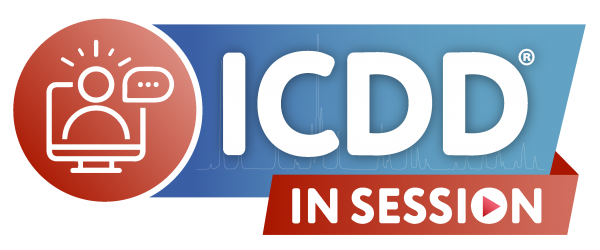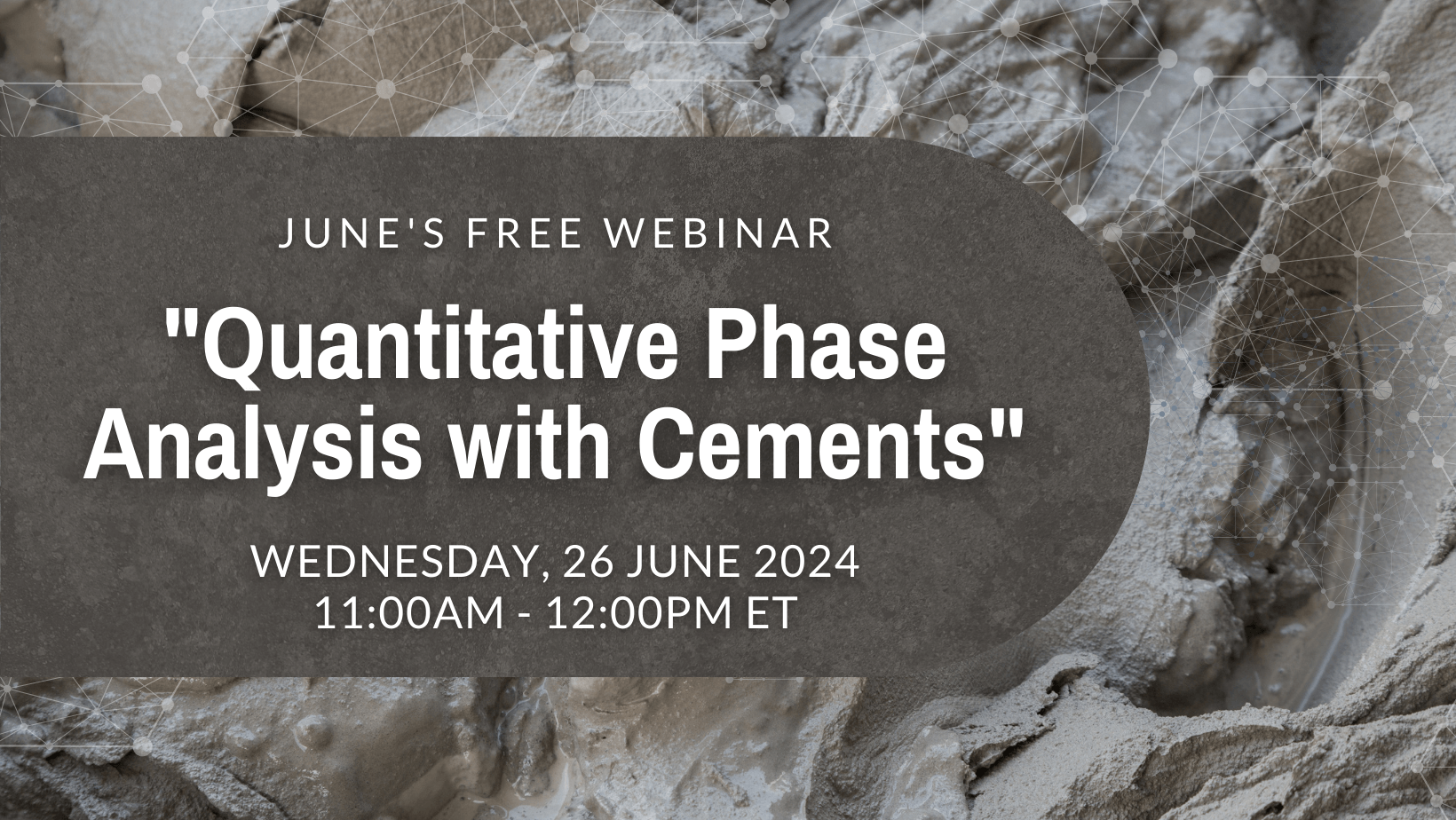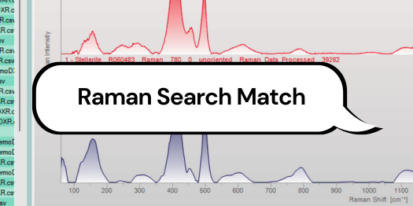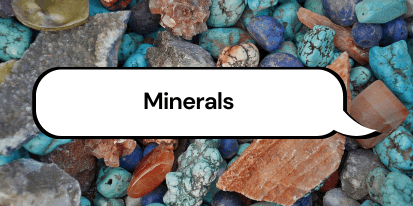
Mastering the PDF® Database and JADE® Software
ICDD’s FREE Webinar Series • Presented by ICDD® and Materials Data®
Welcome to InSession, ICDD’s webinar series, covering topics relating to the Powder Diffraction FileTM and JADE. Learn the potential of each – as well as the powerful combination they become when coupled together! In less than one hour, you will walk away with tips and tools to build confidence and improve productivity. You’ll be guided by ICDD’s and Materials Data’s experts and developers.
Spaces are limited, so ensure you are on our mailing list to receive ICDD Newsletters and be updated about future webinars. See our upcoming webinar topics below.

X-ray diffraction (XRD) analysis is a common technique used to study the crystallographic structure of materials. In this context, XRD analysis can be used to identify the phases present in cement samples and determine each phase’s crystalline structure.
When analyzing cement samples using XRD, it is important to consider the variability that can arise due to differences in raw materials and manufacturing processes. This variability can affect the crystal structure and composition of the cement, making the method and use of references adaptable to different regions.
For demonstration purposes, the PDF-5+ and JADE software packages are commonly used in XRD analysis of cement samples. By using XRD analysis, we can gain valuable insights into the composition and structure of cement, which is essential for understanding its properties and behavior in different applications.
In this webinar, you will learn about:
-
Variabilities
-
Best references to use for QPA
-
Various Methods for QPA
-
Using custom files
-
Using control files
-
Limitations on the accuracy and precision
– Speaker –

Tim Fawcett
Previous Webinars
InSession webinars are free to view. Enter your email, name, and affiliation to watch the most recent PDF Database webinars.
Use the down arrow on the upper left of the video window to navigate to different webinars. Browse the sections below to see the webinar descriptions and speaker bios.
If you are interested in viewing JADE Software InSession webinars, please contact mdi@materialsdata.com.
Quantitative Phase Analysis with Cements
“Quantitative Phase Analysis with Cements”
Speaker: Tim Fawcett
X-ray diffraction (XRD) analysis is a common technique used to study the crystallographic structure of materials. In this context, XRD analysis can be used to identify the phases present in cement samples and determine each phase’s crystalline structure.
When analyzing cement samples using XRD, it is important to consider the variability that can arise due to differences in raw materials and manufacturing processes. This variability can affect the crystal structure and composition of the cement, making the method and use of references adaptable to different regions.
For demonstration purposes, the PDF-5+ and JADE software packages are commonly used in XRD analysis of cement samples. By using XRD analysis, we can gain valuable insights into the composition and structure of cement, which is essential for understanding its properties and behavior in different applications.
In this webinar, you will learn about:
-
Variabilities
-
Best references to use for QPA
-
Various Methods for QPA
-
Using custom files
-
Using control files
-
Limitations on the accuracy and precision
SAED PDF Extension
“SAED PDF Extension”
Speaker: Steffen Weber
Topics covered:
- SAED Simulation (Single/multiple Phases)
- Stereographic Projection
- Structure Display
- Image Display & Manipulation
- Measurement Tools (Scalebar, Ruler, Protractor, Grid)
- Grid Indexing
- Search PDF-5+
Clay Analysis
“Clay Analysis”
Speaker: Anja Dosen
Clays and clay minerals are commonly found in sedimentary rocks and soil. Clays have been in use for centuries, they can be found in ceramic and building materials, catalysts, health and beauty products, nanomaterials and nanocomposites,
air filters, etc.
Clay minerals are layer silicates belonging to the phyllosilicate group. They consist of tetrahedral and octahedral sheets. Tetrahedral sheets consist of infinite layers of SiO4 and AlO4 tetrahedra while, octahedral sheets lie on top of tetrahedral layers and consist of di- or tri-valent cations coordinated with oxygen atoms. Clay minerals usually contain variable amounts of calcium, iron, magnesium, alkali metals, and other cations. Differences in T-O arrangements result in different groups of clay minerals. Due to both similarity and structural diversity, clay minerals are difficult to identify. Powder XRD remains one of the major tools in their identification as each scan represents an average of millions of clay particles.
In this webinar, you will see some of the major steps in clay mineral analysis, like the importance of sample preparation and different methodologies like size separation, preparation of oriented and unoriented samples, and different sample treatments that help in phase identification.
Clay Analysis - Part 2
“Clay Analysis – Part 2”
Speaker: Anja Dosen
Clays and clay minerals are commonly found in sedimentary rocks and soil. Clays have been used for centuries and are found in ceramic and building materials, catalysts, health and beauty products, nanomaterials and nanocomposites, air filters, etc.
Clay minerals are layer silicates with variable amounts of calcium, iron, magnesium, alkali metals, and other cations. Differences in structural arrangement result in different groups of clay minerals. Due to both similarity and structural diversity, clay minerals are difficult to identify. Powder XRD remains one of the major tools in their identification.
In this webinar, you will see examples of clay analysis using the carefully curated clay subfile in the PDF-5+ database. We will show the possibilities for the identification of both oriented and unoriented samples and the modeling of oriented clays using JADE.
New Features of the 2024 PDF Databases
“New Features of the 2024 PDF Databases”
Speaker: Justin Blanton
To enhance the value of the PDF software, ICDD has incorporated many new developments for the 2024 product release. The software allows users to search for 2D structures using a list of templates. Graphing capabilities have been enhanced by implementing automatic vertical zooming, as well as adding a gradient color fill option for x-y plots. PD3 patterns (raw data) can be displayed directly in the search results table for convenient viewing. New file formats such as Rigaku *.asc and *.rasx can now be imported for phase identification. When importing multiple 2D diffraction patterns, the images are dynamically displayed during import with a red line indicating the integration progress. SIeve/SIeve+ allows the user to hide irrelevant matches during analysis and perform a single peak search for trace phases. These are just some of the many value-added developments designed to make the ICDD products more functional and powerful for 2024.
A Pictorial Approach to Comprehend Symmetry in Molecules and Crystals - Parts 1-3
“A Pictorial Approach to Comprehend Symmetry in Molecules and Crystals – Parts 1 -3”
Speaker: Professor T. N. Guru Row, Indian National Science Academy Senior Scientist
The elements of symmetry present in a particular crystalline solid determine its shape and affect its physical properties. An understanding of group theory is essential to appreciate the description of symmetry in crystalline objects. Learn how the numbers 7, 14, 32, and 230 appear among crystals. Grasp concepts of symmetry based on basic geometry through a graphic understanding of molecular and crystal symmetry.
In this webinar, you will learn:
- 3-dimensional objects and representation of stereographic projections
- Why understanding symmetry is crucial in diffraction studies
- Pictorial illustration of symmetry operations leading to point groups
- Translational periodicity and building space groups (equivalent points)
- How diffraction patterns incorporate symmetry
Please note: This InSession takes place in three parts
All you wanted to know about Polymorphism, but were afraid to ask
“All you wanted to know about Polymorphism, but were afraid to ask”
Speaker: Professor T. N. Guru Row, Indian National Science Academy Senior Scientist
Polymorphism is a buzzword in the pharmaceutical industry that arouses curiosity and confusion, particularly when it is mentioned in the context of 100% pure drug substances. XRD studies uniquely clarify that both thermodynamic and kinetic factors drive molecules into this solid-state formulation. In this webinar, through several examples, Dr. Row will outline a clear understanding of the phenomenon and the consequent impact on pharmaceutical products.
In this webinar you will learn:
- The origin of polymorphism
- Types of polymorphism and identification
- Theories based on physical and chemical reasoning for the formation
- Formation of polymorphism, illustrated using examples from ICDD PDF-4 database
- The impact on the industry
2D Pattern Analysis Using the Powder Diffraction File
“2D Pattern Analysis Using the Powder Diffraction File”
Speakers: Justin Blanton, Manager of Engineering and Design & Tom Blanton, ICDD Executive Director
Two-dimensional diffraction data contain abundant information about the phases, microstructure, and orientation of a solid material. In recent years, enhancements in detector technology have increased the use of two-dimensional detectors in academic, government, and industrial laboratories. This InSession webinar will demonstrate how to display X-ray, electron, and neutron two-dimensional diffraction patterns using the ICDD Powder Diffraction File™ (PDF®) databases. Phase identification for data obtained using two-dimensional diffraction data collection will also be presented, along with some new analysis features.
In this webinar, you will learn:
- Display of Ring, SAED, and EBSD diffraction patterns
- Importing two-dimensional data into PDF databases
- Phase identification using two-dimensional diffraction data
Advantages of Using the Powder Diffraction File
“Advantages of Using the Powder Diffraction File”
Speaker: Justin Blanton, Manager of Engineering & Design
The Powder Diffraction File combines the world’s largest sources of inorganic diffraction data from crystals and powders into a single database. The result is a comprehensive collection of inorganic materials, produced in a standardized format that can be rapidly searched for unknown phase identification. The Powder Diffraction File also includes enhanced analytical tools not typically found in other software or database packages.
- Create powder diffraction simulations based on a wide range of radiation types:
- X-ray diffraction
- Neutron diffraction (constant wavelength and time-of-flight)
- 2D (ring) pattern simulations
- Create single crystal electron diffraction simulations:
- Selected area electron diffraction (SAED)
- Electron backscatter diffraction (EBSD)
- Create 3D molecular structures (with support for modulated structures)
- Perform whole pattern matching of non-crystalline/amorphous materials in the database
- Analyze 2D diffraction patterns for phase identification
- Analyze compositions extracted from X-ray fluorescence (XRF) data for phase identification
Q&A Portion of Webinar
ab initio Crystal Structure Solution
“ab initio Crystal Struction Solution – a Primer”
Speaker: Jim Kaduk
- Identifying Structural Analogs
- Indexing: a necessary first step in structure solution
- Lattice Matching Techniques
- Direct Methods and Charge Flipping
- Monte Carlo Simulated Annealing
Data Mining in the Powder Diffraction File
“Data Mining in the Powder Diffraction File”
Speaker: Justin Blanton, Manager of Engineering & Design
The Powder Diffraction File combines the world’s largest sources of inorganic diffraction data from crystals and powders into a single database. The result is a comprehensive collection of inorganic materials, produced in a standardized format that can be rapidly searched for unknown phase identification. Extensive data mining is facilitated with 131 display fields coupled with 77 searches. This allows the user to find PDF entries of interest based on user-defined search criteria.
- Perform searches based on elemental data, crystallographic data, physical properties, classifications, and more.
- Combine multiple searches using Boolean logic.
- Customize your search results by adding display fields and sorting table columns.
- Create X-Y graphs, category graphs, and histograms based on your search results.
Q&A Portion of Webinar
Pharmaceutical Characterization using the Powder Diffraction File
“Pharmaceutical Characterization using the Powder Diffraction File”
Speaker: Tim Fawcett, Former ICDD Executive Director
The analysis of pharmaceuticals and pharmaceutical formulations can be difficult. The materials are often needles or platelets that tend to orient. Many pharmaceuticals are weakly scattering and poor absorbers so instrumental errors such as specimen displacement and transparency are common. A typical tablet formulation can contain noncrystalline, nanocrystalline and amorphous materials as part of the product design so typical single crystal databases have difficulty with the analysis. The PDF-4/Organics database Release 2022 is designed to overcome these difficulties through a combination of having the right types of data, with embedded applications and analysis software. This database has been specifically designed, and subsequently developed, over the last 20 years for pharmaceutical analyses. In this webinar we will explore design features and analysis applications.
In this webinar, you will learn:
- Data mining for specific compounds/polymorphs.
- Subfiles and data types.
- Instrumental corrections.
- Crystallite size and orientation adjustments.
- Identification by Search/Match and Similarity Index.
Q&A Portion of Webinar
Setting Up Your Lab
“Setting Up Your Lab”
Speakers: Tom Blanton, Current ICDD Executive Director, & Tim Fawcett, Former ICDD Executive Director
In this webinar, you will learn:
- Sample preparation
- Complimentary techniques
- Diffractometer tips
- Database and software options
Q&A Portion of Webinar



